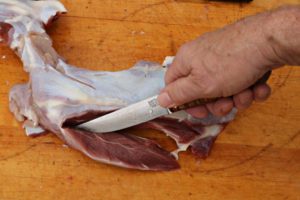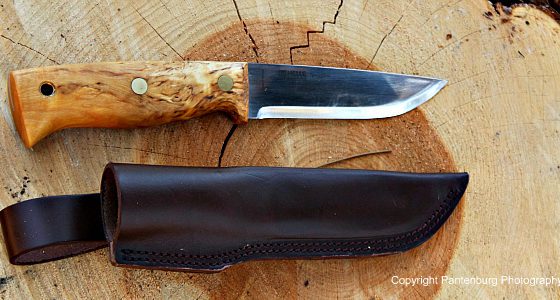One of the most useful knife patterns is the traditional Scandinavian fixed blade. The reason is simple – it flat-out works.
This latest puukko interpretation by Bark River combines modern materials with a proven design.
by Leon Pantenburg
This is the original review I did when the Puukko came out in 2019.
My Bark River Puukko arrived in the mail about an hour before I got started processing a whitetail doe I’d killed a few days before. I washed the knife with soap and water, and put it to work immediately. The knife came razor sharp. It was used for a couple of hours, interchangeably with my go-to Bark River Sportsman and Five Inch Kephart. The knife combination worked just as I thought it would. The three knives were all I needed to completely bone out the carcass. At the end of the meat cutting session, the Puukko was still shaving sharp.
I am a big fan of the Scandinavian pattern knives. For the uninitiated, these knives typically feature a three-to-five inch blade and a thick handle. Though many are works of art, the idea behind them is that they are work/utility knives. One of the best knives for a beginner is a Mora Companion.
These Bark River knives were all I needed to completely bone out and process a deer carcass. From top: Sportsman, Puukko and Five Inch Kephart.
The puukko is a Finnish knife, and the name lends itself to the Finnish word “puukotta,” which means “to stab/knife” according to thetruthaboutknives.com. The prefix, “puu” means “wood” in Finnish.
The puukko’s design is attributed to the indigenous Sami people, who created several knives to use for day-to-day tasks; the puukko was the smaller option, used to skin fish or animals. Although historical records vary, the puukko dates back about 1,000 years. Both men and women carried (and carry) puukkos, although the sizes change depending on the person. The puukko handle is meant to fit the hand size of the user.
Specifications (Courtesy of Knivesshipfree.com)
Overall Length: 8.83″
Blade Length: 4.25″
Blade Steel: CPM-3V
Blade Thickness: .125″
Weight: 5.0oz.
Made in Escanaba, MI Leather belt sheath included
So far, I’ve only used the BR puukko for a couple of hours meatcutting. But it will get more use very soon, since the Mississippi deer season is just getting going. I have used similar puukko and Mora design knives for more than a decade, and they have proven to be very useful and handy to carry.
The good stuff:
Design: Several of my Scandinavian-style knives are used regularly, so there was no sales resistance at all when the Puukko came on the market. The puukko design is for someone who wants a utility knife that can work. I ordered mine with a curly maple handle, because nothing says a utility knife can’t be good looking.
Steel: The knife comes in CPM 3V, which is one of my favorite user steels. Any steel can rust, but 3V seems to resist corrosion very well in the hot, humid environment of Mississippi where I live. I don’t have a problem with the steel staining – immediately upon finishing the hunting or fishing field work, I hit the blade with an alcohol wipe, followed by a another wipedown with a dry paper towel. This only takes a minute, and the cleanup will last until the blade can be thoroughly washed with soap and water.
Point: This blade has a straight spine and the edge curves up to meet it at the tip. This is a good configuration for doing skinning around the neck and shoulders of a deer or elk. It also works well for meat cutting.
The Puukko was put to work immediately, and proved to be a great wild game processing tool.
Belly: The belly of a blade is the curve from the tip to where the edge straightens out. The belly does the work when skinning. The Puukko design is not supposed to be a skinner, but it works well for that. If you anticipate needing a designated skinner, look for a knife with a more rounded belly.
Blade length: Most of my hunting knives have blades between four and five inches. This has proven to be the best length for overall hunting and bushcraft use. My go-to deer and elk hunting knives, the Ambush Tundra and Bark River Bravo 1.25 LT have those length blades, and they have proven themselves multiple times on deer and elk.
Handle: The straight puukko handle sometimes puts potential buyers off. Shouldn’t there be some sort of guard to keep your hand from sliding down on the blade? Truth be told, hand guards or quillons, are a fairly recent innovation. Most mountain men carried basic butcher knives for everyday use. The original Bowie knives didn’t have quillons. After the Bowie became the rage of the frontier in the 1830s, all sorts of hand guard variations emerged, as well as a styled system of knife fighting.
I’ve never had a problem with my hand sliding onto a blade, and I’ve used guardless Scandinavian-style knives when they were covered with fish slime and blood. The late Mors Kochanski commented in a YouTube video that in 50 years of teaching bushcraft, he had never seen anyone injured by their hand sliding off the handle onto the blade.
Made in Escanoba, Michigan: When you buy American-made products, that means an American worker is making a living wage. It also means that they are paying local, state and federal taxes. These workers contribute to their local economies, and to their communities.
Do you need a Bark River puukko?
Many puukkos are works of art, and they can easily become safe queens. But I see a particular beauty in an art object, such as a fine knife, that can also be a useful working tool. With the Bark River Puukko you get both.
Please click here to check out and subscribe to the SurvivalCommonSense.com YouTube channel – thanks!





Leave a Reply